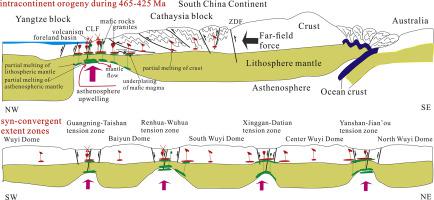当前位置:
X-MOL 学术
›
Gondwana Res.
›
论文详情
Our official English website, www.x-mol.net, welcomes your
feedback! (Note: you will need to create a separate account there.)
Origin of the Heping granodiorite pluton: Implications for syn-convergent extension and asthenosphere upwelling accompanying the early Paleozoic orogeny in South China
Gondwana Research ( IF 7.2 ) Pub Date : 2020-09-01 , DOI: 10.1016/j.gr.2020.04.002 Yuexin Xie , Liyan Ma , Guochun Zhao , Caifu Xie , Yigui Han , Jianhua Li , Qian Liu , Jinlong Yao , Yunying Zhang , Yuanfa Lu
Gondwana Research ( IF 7.2 ) Pub Date : 2020-09-01 , DOI: 10.1016/j.gr.2020.04.002 Yuexin Xie , Liyan Ma , Guochun Zhao , Caifu Xie , Yigui Han , Jianhua Li , Qian Liu , Jinlong Yao , Yunying Zhang , Yuanfa Lu

|
Abstract We present geochemical and geochronological data of host granodiorites and mafic microgranular enclaves (MMEs) from the Heping pluton, which is situated in the central part of the Wuyi-Yunkai Orogen (WYO) in the South China Block (SCB), and reveal syn-convergent extension and asthenosphere upwelling during the early Paleozoic intracontinental orogeny. Two host and two MME samples from the Heping pluton yield LA-ICP-MS zircon U Pb ages of ca. 445 Ma, coincident with the peak magmatism-metamorphism of the WYO. The host granodioritic samples are metaluminous (A/CNK = 0.68–0.91) and have abundant amphibole and low-moderate SiO2 (59.1 to 67.3 wt%), belonging to high-K calc-alkaline I-type granite, whereas the MMEs are more basic with SiO2 of 56.3 to 59.6 wt%. Both the host and MME samples display weakly negative Eu anomalies and distinctly relative depletions of Ta, Nb, and Ti, and most of them share similar initial 87Sr/86Sr ratios of 0.7089–0.7112 and eNd(t) values of −6.52 to −7.12, except one MME sample with a lower initial 87Sr/86Sr of 0.70758 and a higher eNd(t) of −4.33. The zircon eHf(t) values exhibit a wide range from −13.68 to −0.87. Petrological, geochemical, and chronological data suggest that the Heping pluton were generated by mingling of mafic and felsic magmas. The mafic endmember magma was originated mainly from the enriched subcontinental lithosphere mantle at the spinel–garnet transitional zone (~70 km), subsequently underplated/intraplated into the lower-middle crust resulting in the melting of the intermediate rock at pressure
中文翻译:

和平花岗闪长岩成因: 伴随华南早古生代造山运动的同会聚伸展和软流圈上涌的意义
摘要 我们展示了位于华南地块(SCB)武夷-云开造山带(WYO)中部的和平岩体中寄主花岗闪长岩和镁铁质微粒包体(MMEs)的地球化学和年代学数据,并揭示了- 早古生代陆内造山运动期间的会聚伸展和软流圈上升流。来自和平岩体的两个宿主和两个 MME 样品产生了大约 20 年的 LA-ICP-MS 锆石 U Pb 年龄。445 Ma,与 WYO 的峰值岩浆作用-变质作用一致。主体花岗闪长岩样品为金属铝质(A/CNK = 0.68-0.91),具有丰富的闪石和低中度 SiO2(59.1 至 67.3 wt%),属于高 K 钙碱性 I 型花岗岩,而 MMEs 更多SiO2 为 56.3 至 59.6 wt% 的碱性。宿主和 MME 样品都显示出弱的负 Eu 异常和明显的 Ta、Nb 和 Ti 相对消耗,并且它们中的大多数具有相似的初始 87Sr/86Sr 比率为 0.7089–0.7112 和 eNd(t) 值为 -6.52 到 -7.12 ,除了一个 MME 样品的初始 87Sr/86Sr 较低,为 0.70758,eNd(t) 较高,为 -4.33。锆石 eHf(t) 值的范围很广,从 -13.68 到 -0.87。岩石学、地球化学和年代学数据表明和平岩体是由基性岩浆和长英质岩浆混合形成的。基性端元岩浆主要来源于尖晶石-石榴石过渡带(~70 km)富集的次大陆岩石圈地幔,随后欠镀/内镀到中下地壳,导致中间岩石在压力下熔化 它们中的大多数具有相似的初始 87Sr/86Sr 比率 0.7089-0.7112 和 -6.52 到 -7.12 的 eNd(t) 值,除了一个 MME 样品具有较低的初始 87Sr/86Sr 0.70758 和较高的 eNd(t) - 4.33. 锆石 eHf(t) 值的范围很广,从 -13.68 到 -0.87。岩石学、地球化学和年代学数据表明和平岩体是由基性岩浆和长英质岩浆混合形成的。基性端元岩浆主要来源于尖晶石-石榴石过渡带(~70 km)富集的次大陆岩石圈地幔,随后欠镀/内镀到中下地壳,导致中间岩石在压力下熔化 它们中的大多数具有相似的初始 87Sr/86Sr 比率 0.7089-0.7112 和 -6.52 到 -7.12 的 eNd(t) 值,除了一个 MME 样品具有较低的初始 87Sr/86Sr 0.70758 和较高的 eNd(t) - 4.33. 锆石 eHf(t) 值的范围很广,从 -13.68 到 -0.87。岩石学、地球化学和年代学数据表明和平岩体是由基性岩浆和长英质岩浆混合形成的。基性端元岩浆主要来源于尖晶石-石榴石过渡带(~70 km)富集的次大陆岩石圈地幔,随后欠镀/内镀到中下地壳,导致中间岩石在压力下熔化 70758 和更高的 eNd(t) -4.33。锆石 eHf(t) 值的范围很广,从 -13.68 到 -0.87。岩石学、地球化学和年代学数据表明和平岩体是由基性岩浆和长英质岩浆混合形成的。基性端元岩浆主要来源于尖晶石-石榴石过渡带(~70 km)富集的次大陆岩石圈地幔,随后欠镀/内镀到中下地壳,导致中间岩石在压力下熔化 70758 和更高的 eNd(t) -4.33。锆石 eHf(t) 值的范围很广,从 -13.68 到 -0.87。岩石学、地球化学和年代学数据表明和平岩体是由基性岩浆和长英质岩浆混合形成的。基性端元岩浆主要来源于尖晶石-石榴石过渡带(~70 km)富集的次大陆岩石圈地幔,随后欠镀/内镀到中下地壳,导致中间岩石在压力下熔化
更新日期:2020-09-01
中文翻译:

和平花岗闪长岩成因: 伴随华南早古生代造山运动的同会聚伸展和软流圈上涌的意义
摘要 我们展示了位于华南地块(SCB)武夷-云开造山带(WYO)中部的和平岩体中寄主花岗闪长岩和镁铁质微粒包体(MMEs)的地球化学和年代学数据,并揭示了- 早古生代陆内造山运动期间的会聚伸展和软流圈上升流。来自和平岩体的两个宿主和两个 MME 样品产生了大约 20 年的 LA-ICP-MS 锆石 U Pb 年龄。445 Ma,与 WYO 的峰值岩浆作用-变质作用一致。主体花岗闪长岩样品为金属铝质(A/CNK = 0.68-0.91),具有丰富的闪石和低中度 SiO2(59.1 至 67.3 wt%),属于高 K 钙碱性 I 型花岗岩,而 MMEs 更多SiO2 为 56.3 至 59.6 wt% 的碱性。宿主和 MME 样品都显示出弱的负 Eu 异常和明显的 Ta、Nb 和 Ti 相对消耗,并且它们中的大多数具有相似的初始 87Sr/86Sr 比率为 0.7089–0.7112 和 eNd(t) 值为 -6.52 到 -7.12 ,除了一个 MME 样品的初始 87Sr/86Sr 较低,为 0.70758,eNd(t) 较高,为 -4.33。锆石 eHf(t) 值的范围很广,从 -13.68 到 -0.87。岩石学、地球化学和年代学数据表明和平岩体是由基性岩浆和长英质岩浆混合形成的。基性端元岩浆主要来源于尖晶石-石榴石过渡带(~70 km)富集的次大陆岩石圈地幔,随后欠镀/内镀到中下地壳,导致中间岩石在压力下熔化 它们中的大多数具有相似的初始 87Sr/86Sr 比率 0.7089-0.7112 和 -6.52 到 -7.12 的 eNd(t) 值,除了一个 MME 样品具有较低的初始 87Sr/86Sr 0.70758 和较高的 eNd(t) - 4.33. 锆石 eHf(t) 值的范围很广,从 -13.68 到 -0.87。岩石学、地球化学和年代学数据表明和平岩体是由基性岩浆和长英质岩浆混合形成的。基性端元岩浆主要来源于尖晶石-石榴石过渡带(~70 km)富集的次大陆岩石圈地幔,随后欠镀/内镀到中下地壳,导致中间岩石在压力下熔化 它们中的大多数具有相似的初始 87Sr/86Sr 比率 0.7089-0.7112 和 -6.52 到 -7.12 的 eNd(t) 值,除了一个 MME 样品具有较低的初始 87Sr/86Sr 0.70758 和较高的 eNd(t) - 4.33. 锆石 eHf(t) 值的范围很广,从 -13.68 到 -0.87。岩石学、地球化学和年代学数据表明和平岩体是由基性岩浆和长英质岩浆混合形成的。基性端元岩浆主要来源于尖晶石-石榴石过渡带(~70 km)富集的次大陆岩石圈地幔,随后欠镀/内镀到中下地壳,导致中间岩石在压力下熔化 70758 和更高的 eNd(t) -4.33。锆石 eHf(t) 值的范围很广,从 -13.68 到 -0.87。岩石学、地球化学和年代学数据表明和平岩体是由基性岩浆和长英质岩浆混合形成的。基性端元岩浆主要来源于尖晶石-石榴石过渡带(~70 km)富集的次大陆岩石圈地幔,随后欠镀/内镀到中下地壳,导致中间岩石在压力下熔化 70758 和更高的 eNd(t) -4.33。锆石 eHf(t) 值的范围很广,从 -13.68 到 -0.87。岩石学、地球化学和年代学数据表明和平岩体是由基性岩浆和长英质岩浆混合形成的。基性端元岩浆主要来源于尖晶石-石榴石过渡带(~70 km)富集的次大陆岩石圈地幔,随后欠镀/内镀到中下地壳,导致中间岩石在压力下熔化











































 京公网安备 11010802027423号
京公网安备 11010802027423号